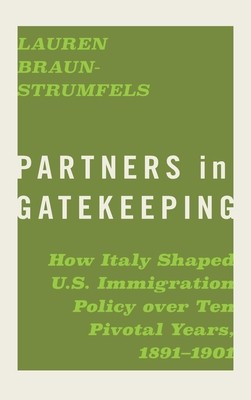
- We will send in 10–14 business days.
- Author: Lauren Braun-Strumfels
- Publisher: University of Georgia Press
- ISBN-10: 0820365416
- ISBN-13: 9780820365411
- Format: 15.2 x 22.9 x 1.6 cm, hardcover
- Language: English
- SAVE -10% with code: EXTRA
Reviews
Description
Partners in Gatekeeping illuminates a complex, distinctly transnational story that recasts the development of U.S. immigration policies and institutions. Lauren Braun-Strumfels challenges existing ideas about the origins of remote control by paying particular attention to two programs supported by the Italian government in the 1890s: a government outpost on Ellis Island called the Office of Labor Information and Protection for Italians, and rural immigrant colonization in the American South--namely a plantation in Arkansas called Sunnyside.
Through her examination of these distinctlocations, Braun-Strumfels argues that we must consider Italian migration as an essential piece in the history of how the United States became a gatekeeping nation. In particular, she details how an asymmetric partnership emerged between the United States and Italy to manage that migration. In so doing, Partnersin Gatekeeping reveals that the last ten years of the nineteenth century were critical to the establishment of the modern gatekeeping system.By showing the roles of the Italian programs in this migration system, Braun-Strumfels establishes antecedents for remote control beyond the well-studied Chinese and Mexican cases.EXTRA 10 % discount with code: EXTRA
The promotion ends in 20d.04:55:30
The discount code is valid when purchasing from 10 €. Discounts do not stack.
- Author: Lauren Braun-Strumfels
- Publisher: University of Georgia Press
- ISBN-10: 0820365416
- ISBN-13: 9780820365411
- Format: 15.2 x 22.9 x 1.6 cm, hardcover
- Language: English English
Partners in Gatekeeping illuminates a complex, distinctly transnational story that recasts the development of U.S. immigration policies and institutions. Lauren Braun-Strumfels challenges existing ideas about the origins of remote control by paying particular attention to two programs supported by the Italian government in the 1890s: a government outpost on Ellis Island called the Office of Labor Information and Protection for Italians, and rural immigrant colonization in the American South--namely a plantation in Arkansas called Sunnyside.
Through her examination of these distinctlocations, Braun-Strumfels argues that we must consider Italian migration as an essential piece in the history of how the United States became a gatekeeping nation. In particular, she details how an asymmetric partnership emerged between the United States and Italy to manage that migration. In so doing, Partnersin Gatekeeping reveals that the last ten years of the nineteenth century were critical to the establishment of the modern gatekeeping system.By showing the roles of the Italian programs in this migration system, Braun-Strumfels establishes antecedents for remote control beyond the well-studied Chinese and Mexican cases.

Reviews